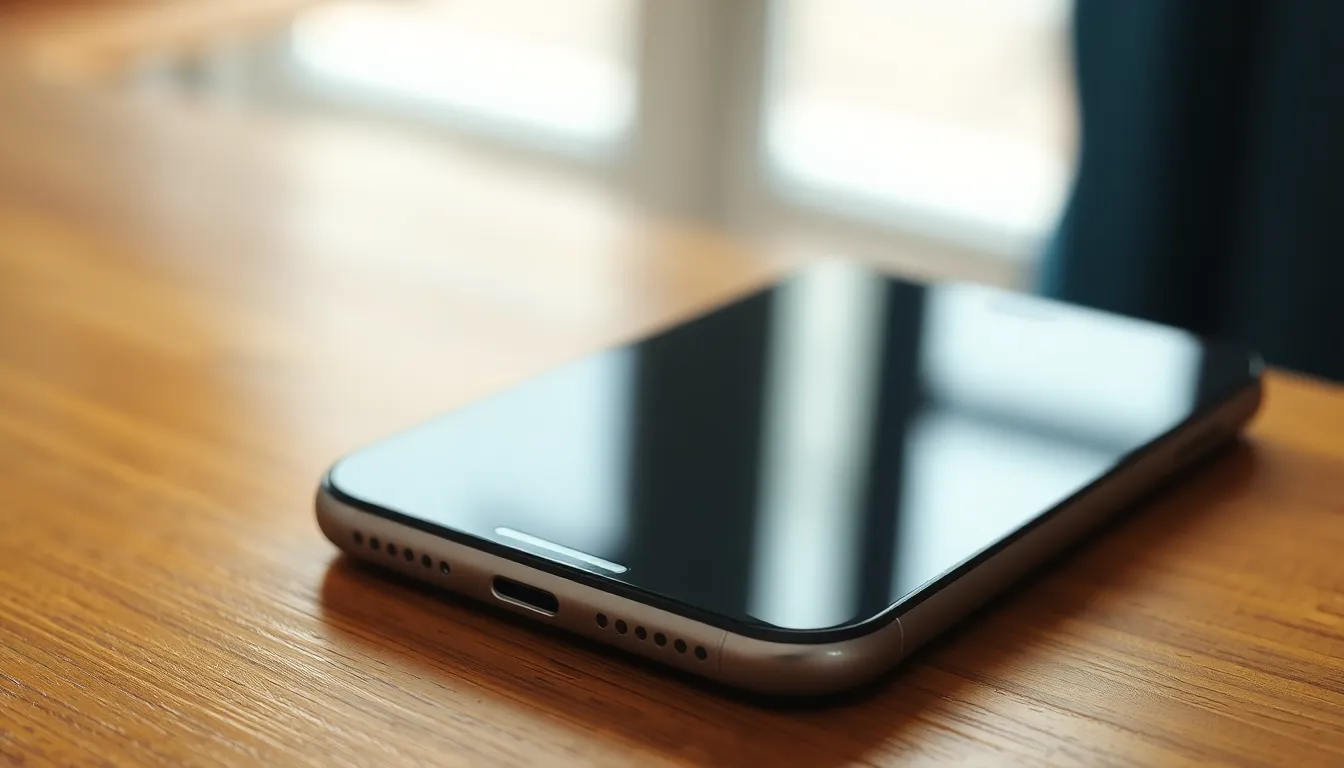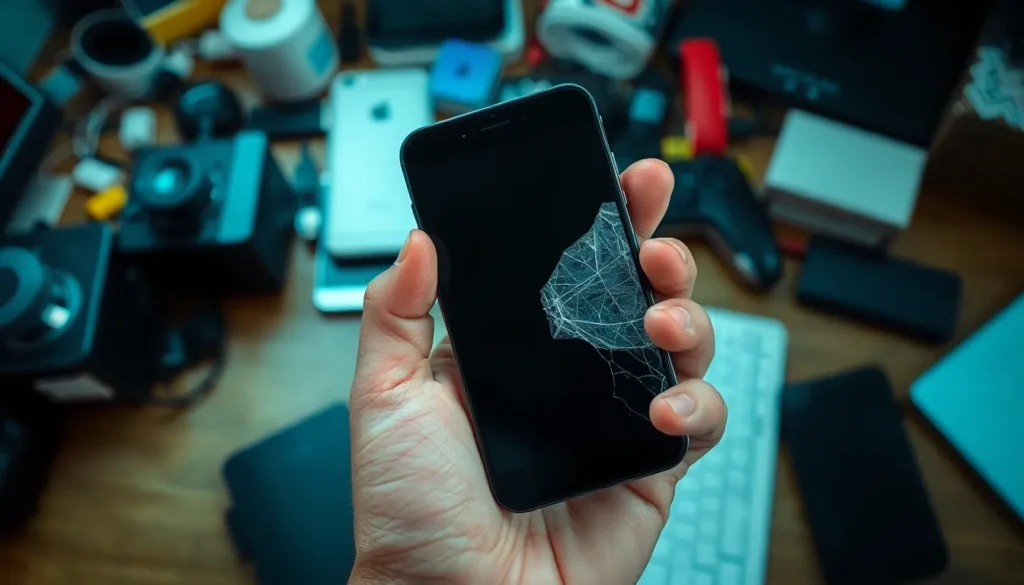Table of Contents
ToggleImagine this: you’re scrolling through your favorite memes, and suddenly, the right side of your iPhone screen decides to take an unscheduled vacation. Panic sets in. Is it a technical glitch or did your phone just develop a rebellious streak?
This frustrating issue can leave anyone feeling like they’ve lost a limb in the digital world. The right side of the screen is where all the magic happens—messages, apps, and those all-important cat videos. Understanding why this happens is crucial for getting back to business (or binge-watching).
Understanding the Issue
The unresponsiveness of the right side of an iPhone screen can stem from several factors. Hardware malfunctions commonly lead to this issue. For instance, screen damage, such as cracks or scratches, impairs touch sensitivity, primarily affecting the right side. Similarly, liquid exposure can disrupt internal components, resulting in unresponsiveness.
Software glitches also play a significant role. A recent update may cause compatibility issues with existing apps, leading to erratic behavior. In some cases, a simple restart resolves these glitches, making the screen responsive again. Outdated applications can contribute to this problem as well; ensuring they’re up-to-date can enhance overall performance.
Touchscreen calibration sometimes presents issues. An improperly calibrated screen may not register touches accurately, particularly on specific edges like the right side. Using the calibration settings can rectify this issue, providing a better user experience.
Nonetheless, environmental factors also contribute. Extreme temperatures or humidity can cause temporary malfunctions. Keeping the device within recommended conditions helps maintain optimal functionality.
Checking for debris or dirt is essential, too, as buildup on the screen may hinder touch responsiveness. Routine cleaning with a soft, lint-free cloth keeps the device in good condition.
Consulting a professional is advisable for persistent issues. Technicians can diagnose hardware and software problems accurately, providing the right solutions.
Common Causes of Screen Malfunction

Understanding the common causes of screen malfunction helps diagnose the issue effectively. Various factors may contribute to the right side of an iPhone screen becoming unresponsive.
Hardware Issues
Hardware issues frequently lead to touch screen malfunctions. Cracks or scratches can compromise the screen’s integrity, impacting responsiveness. Liquid exposure often results in permanent damage, affecting touch sensitivity significantly. A damaged flex cable might also disrupt communication between the screen and logic board. Users should conduct a visual inspection for visible signs of damage. If detected, professional repair becomes necessary. Regularly handling the device with care minimizes the risk of future hardware issues.
Software Glitches
Software glitches often present as temporary unresponsiveness. Recent updates might introduce bugs, while outdated apps can affect overall performance. Restarting the device frequently resolves many software-related issues. Users might also consider resetting settings to eliminate conflicts. Application interference sometimes causes touch screen problems, necessitating updates to ensure compatibility. Keeping the system software up to date, as well as optimizing app performance, reduces the likelihood of glitches.
Troubleshooting Steps
Addressing unresponsiveness on the right side of the iPhone screen requires systematic troubleshooting. Users can take various steps to identify and potentially resolve the issue.
Restart Your iPhone
Restarting the iPhone often resolves temporary glitches. To do this, hold down the side and volume buttons until the power off slider appears. Once the device powers off, wait for about 30 seconds before turning it back on by pressing the side button. This process refreshes the operating system and may restore touch responsiveness.
Check for Software Updates
Missing software updates can lead to issues with touch sensitivity. Navigate to Settings, then select General and Software Update. If any updates are available, downloading and installing them can fix bugs responsible for the screen not responding. Regularly checking for updates ensures the device runs smoothly and takes advantage of the latest features.
Reset All Settings
Resetting all settings returns the device to its default configurations without deleting personal data. This option is found under Settings, then General, followed by Reset. Tap on Reset All Settings, and confirm the action. After performing this step, users may notice improvements in screen responsiveness, as it clears any problematic settings.
When to Seek Professional Help
Considering the right side of an iPhone screen exhibits consistent unresponsiveness, seeking professional help becomes essential. Ongoing issues, despite attempts at troubleshooting, often signal underlying hardware damage or severe software complications. Hardware problems may include a damaged flex cable or other internal components requiring expert intervention.
Concern about liquid exposure should not be taken lightly, as moisture can lead to extensive damage, affecting functionality. Users noticing cracks or deep scratches should consult a technician for repair, as these defects can severely impact touchscreen communication.
Software glitches creating repeat problems might prompt users to seek help if simple fixes, like restarting or resetting settings, do not work. Frequent and unexplained touch sensitivity issues can indicate deeper software conflicts that a professional can properly diagnose.
Environmental factors, such as excessive heat or humidity, could exacerbate these problems. If the device was subjected to such conditions recently, it might require professional assessment. Dust, dirt, or debris buildup can also hinder screen responsiveness. In these cases, a technician can ensure a thorough cleaning and proper function.
Users should prioritize contacting a repair center when they’ve exhausted troubleshooting options. Maintaining appropriate device performance is crucial for ongoing usability, especially when the right side of the iPhone screen is vital for accessing messages, apps, and entertainment.
Addressing the issue of an unresponsive right side of the iPhone screen is crucial for maintaining a seamless user experience. Whether it’s a minor software glitch or a more serious hardware problem understanding the potential causes can help users take appropriate action. Regular maintenance like cleaning the screen and keeping software updated can prevent many issues.
If the problem persists after troubleshooting it’s wise to seek professional assistance. Ignoring the signs of damage or malfunction could lead to further complications. By staying informed and proactive users can ensure their iPhone remains functional and reliable.




